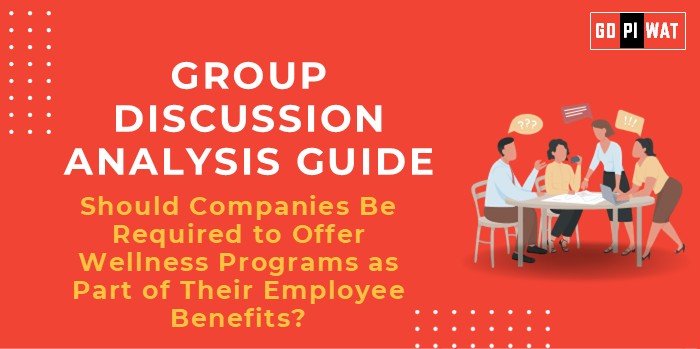📋 Group Discussion Analysis Guide: Should Companies Be Required to Offer Wellness Programs as Part of Their Employee Benefits?
🌐 Introduction to the Topic
Opening Context:
💡 Employee wellness programs are increasingly being recognized as integral to workplace culture, enhancing productivity and reducing healthcare costs. Globally, companies are integrating wellness initiatives to attract and retain talent, reflecting a shift towards holistic employee well-being.
Topic Background:
🌍 Wellness programs gained prominence in the late 20th century as companies sought to address rising healthcare expenses and burnout. Post-pandemic, this debate has gained urgency, as employee well-being directly correlates with organizational success. Key components of these programs include mental health support, physical fitness incentives, and stress management workshops.
📊 Quick Facts and Key Statistics
- 📉 Workplace Productivity Loss: 15-20% of annual productivity loss globally is due to poor employee health (WHO, 2023).
- 📈 Corporate Benefits: Companies offering wellness programs report a 20% decrease in absenteeism (SHRM, 2022).
- 💰 ROI on Wellness: For every $1 invested in wellness, employers save $3.27 in healthcare costs (RAND Corporation).
- ⚕️ Stress Impact: Workplace stress is linked to 120,000 deaths annually in the U.S., costing $190 billion in healthcare (Harvard Business Review).
🤝 Stakeholders and Their Roles
- 🏢 Employers: Initiate and implement wellness programs.
- 👩💼 Employees: Active participants and beneficiaries of wellness initiatives.
- 🏛️ Governments: Enforce regulatory frameworks, offering tax incentives for wellness programs.
- 🏥 Healthcare Providers: Develop programs addressing specific health challenges.
- 📄 Insurance Companies: Integrate wellness initiatives into coverage plans to reduce claims.
🏆 Achievements and Challenges
Achievements:
- ✅ Cost Savings: Companies like Johnson & Johnson saved $250 million on healthcare over a decade through wellness programs.
- ✅ Improved Productivity: Organizations with robust wellness programs report a 10% increase in employee performance.
- ✅ Enhanced Recruitment: Over 60% of employees prefer companies offering wellness programs.
Challenges:
- ⚠️ Cost of Implementation: Small businesses struggle to fund comprehensive programs.
- ⚠️ Participation Rates: Only 24% of employees fully utilize offered wellness benefits.
- ⚠️ Cultural Barriers: Stigma around mental health discourages participation.
Global Comparisons:
- 🌟 U.S.: Leading in corporate wellness integration, driven by insurance benefits.
- 🌟 Nordic Countries: Wellness is embedded into labor laws, ensuring universal access.
📖 Case Studies:
- 🇺🇸 Google: Comprehensive wellness programs, including on-site fitness centers, yoga, and mental health counselors, yield high employee satisfaction.
- 🇮🇳 Infosys (India): Introduced mental health support post-pandemic, with a 35% reduction in reported stress cases.
🧠 Structured Arguments for Discussion
Supporting Stance:
✨ “Wellness programs reduce healthcare costs and absenteeism, ultimately boosting productivity.”
Opposing Stance:
⚠️ “Mandatory wellness programs strain company budgets, especially for small businesses, without guaranteed ROI.”
Balanced Perspective:
💡 “While wellness programs benefit employees, their success depends on tailored implementation and active participation.”
🎯 Effective Discussion Approaches
Opening Approaches:
- 📊 Start with global trends in workplace wellness and their measurable impacts.
- 📈 Highlight a compelling statistic, such as the ROI of wellness programs.
Counter-Argument Handling:
- 💡 Address cost concerns by referencing scalable solutions like digital wellness apps.
- 💡 Emphasize long-term benefits outweighing short-term investments.
📈 Strategic Analysis: SWOT
- 💪 Strengths: Improved employee retention, reduced healthcare costs.
- 🔍 Weaknesses: High initial setup costs, low participation rates.
- 🌟 Opportunities: Integration with AI-based health tracking.
- ⚠️ Threats: Privacy concerns over health data.
📖 Connecting with B-School Applications
Real-World Applications:
- 💼 Linking wellness programs to strategic HR management, cost optimization, and CSR.
Sample Interview Questions:
- ❓ “How do wellness programs contribute to organizational success?”
- ❓ “Should wellness initiatives be a policy requirement or voluntary?”
Insights for Students:
- 💡 Explore intersections between wellness and workplace culture in MBA projects or case studies.


